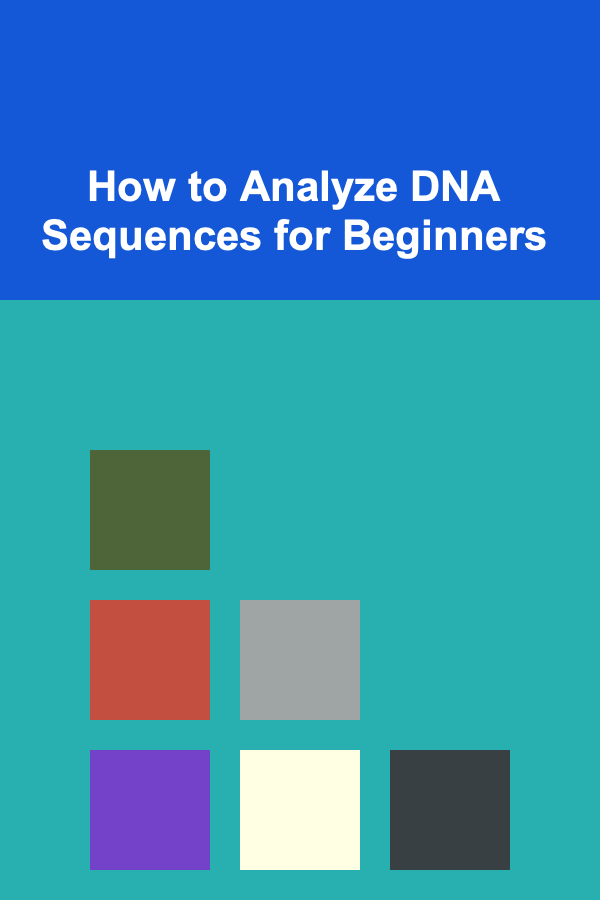
How to Analyze DNA Sequences for Beginners
ebook include PDF & Audio bundle (Micro Guide)
$12.99$7.99
Limited Time Offer! Order within the next:

DNA sequence analysis is an essential tool in molecular biology, bioinformatics, genetics, and medicine. Understanding how to interpret and analyze DNA sequences can offer insights into gene function, evolutionary relationships, and the genetic basis of disease. For beginners, diving into DNA sequence analysis can seem daunting, but with the right tools, knowledge, and approach, it becomes an accessible and rewarding skill. In this article, we'll explore the fundamental concepts and practical steps involved in analyzing DNA sequences, providing a comprehensive guide for beginners.
Understanding DNA Sequences
DNA (deoxyribonucleic acid) is a molecule that contains the genetic instructions for the development, functioning, growth, and reproduction of all living organisms. These instructions are encoded in the sequence of nucleotides, the basic building blocks of DNA. A nucleotide is composed of a sugar molecule, a phosphate group, and a nitrogenous base.
The Four Nitrogenous Bases of DNA
DNA consists of four nitrogenous bases:
- Adenine (A)
- Thymine (T)
- Cytosine (C)
- Guanine (G)
These bases pair in specific ways: Adenine pairs with Thymine, and Cytosine pairs with Guanine. This complementary base pairing allows for the double-stranded structure of DNA.
What is a DNA Sequence?
A DNA sequence is simply the order of these nitrogenous bases along a DNA strand. For example, a short DNA sequence might look like this:
Each sequence represents genetic information, and analyzing these sequences helps researchers understand various biological processes.
Steps to Analyze DNA Sequences
Analyzing DNA sequences involves a series of steps that range from simple visual inspection to more advanced bioinformatics techniques. Below, we'll walk through the basic steps of DNA sequence analysis.
Step 1: Obtain the DNA Sequence
Before you can begin analyzing a DNA sequence, you need to obtain it. DNA sequences are often generated using sequencing technologies such as Sanger sequencing or next-generation sequencing (NGS). Once obtained, these sequences are typically stored in FASTA or GenBank formats.
-
FASTA Format : A widely-used text-based format that includes a description line (beginning with a
>symbol) followed by the DNA sequence.ATGCGTACG... -
GenBank Format: A more detailed format that includes additional metadata such as organism name, gene names, and functional annotations.
Step 2: Visualize the DNA Sequence
The first step in analyzing a DNA sequence is to visualize it. This involves looking at the sequence to understand its general structure and content. A sequence might contain specific motifs, repetitive elements, or regions of interest such as genes, regulatory sequences, or introns and exons.
Tools for Visualization:
- Basic Text Editors: You can open a FASTA or GenBank file in any text editor, but these are typically hard to read when the sequence is long.
- Bioinformatics Software: Tools like SnapGene, Benchling, or UGENE can help visualize sequences with more user-friendly interfaces.
- Online Tools: Websites like NCBI BLAST or EMBL-EBI also provide simple sequence visualization tools.
Step 3: Identify the Reading Frame
In DNA sequences, the coding regions that encode proteins are arranged in specific reading frames. Identifying these frames is essential to understand the possible proteins that can be encoded by the sequence.
How to Find the Reading Frame:
- Start Codon : The coding sequence usually begins with a start codon,
ATG, which signals the beginning of a gene. - Stop Codon : Proteins are translated until a stop codon (
TAA,TAG, orTGA) is encountered.
Once the start and stop codons are identified, you can translate the nucleotide sequence into an amino acid sequence using the genetic code.
Step 4: Use BLAST for Sequence Similarity Search
One of the most common steps in DNA sequence analysis is comparing the sequence to a reference database to find similar sequences. This is often done using BLAST (Basic Local Alignment Search Tool), a tool that compares your sequence to known sequences in databases such as GenBank or RefSeq.
How to Use BLAST:
- Access NCBI BLAST : Go to the NCBI website and choose a BLAST program (such as
blastnfor nucleotide sequences). - Submit Your Sequence: Paste your DNA sequence in FASTA format into the input box.
- Select Database: Choose a reference database to compare your sequence against.
- Run the Search: BLAST will compare your sequence to those in the database and return a list of similar sequences, showing the degree of similarity and alignment.
BLAST is extremely helpful for identifying known genes or homologous sequences from other organisms.
Step 5: Analyze Gene Function and Annotation
Once you have a DNA sequence, the next step is to interpret what the sequence represents. Often, sequences are annotated with gene names, functional elements, and other biological information. If your sequence doesn't have annotations, you can predict potential genes or functional regions using various tools.
Tools for Gene Prediction:
- GeneMark: A tool for predicting genes in prokaryotic and eukaryotic genomes.
- AUGUSTUS: A program for gene prediction in eukaryotic genomes.
- UCSC Genome Browser: A powerful resource for genome annotations, allowing you to visualize your sequence in the context of known genes and other genomic features.
By predicting and annotating genes in your sequence, you can gain insights into its function and its potential role in the organism.
Step 6: Examine Mutations and Variants
DNA sequence analysis is often used to identify genetic mutations, such as single nucleotide polymorphisms (SNPs), insertions, deletions, or structural variations. These mutations can have important implications for disease, evolution, or drug response.
Tools for Mutation Analysis:
- Variant Call Format (VCF): VCF files store information about variants in a DNA sequence. Tools like GATK (Genome Analysis Toolkit) and SAMtools can help call and analyze variants.
- dbSNP: A public database that catalogs known SNPs. It can be used to compare your sequence against known variants.
- Ensembl Variant Effect Predictor (VEP): A tool for annotating variants in your DNA sequence and predicting their effects on gene function.
Step 7: Perform Multiple Sequence Alignment
In some cases, you might want to compare multiple DNA sequences to understand evolutionary relationships or identify conserved regions. Multiple sequence alignment (MSA) aligns several sequences to reveal similarities and differences among them.
How to Perform MSA:
- Clustal Omega: A widely-used tool for multiple sequence alignment.
- MUSCLE: Another popular tool for MSA that's known for its speed and accuracy.
By aligning multiple sequences, you can identify conserved motifs or genes, which may have important functional significance.
Advanced Techniques in DNA Sequence Analysis
After covering the basics, you may want to explore more advanced techniques in DNA sequence analysis. These methods are essential for large-scale genomic studies, disease research, or evolutionary biology.
Phylogenetic Analysis
Phylogenetic analysis involves constructing a tree to represent the evolutionary relationships between different DNA sequences. This is particularly useful in understanding how different species or strains are related based on their genetic material.
- Tools for Phylogenetic Analysis: MEGA (Molecular Evolutionary Genetics Analysis) is a popular tool for building phylogenetic trees based on DNA sequence data.
RNA-Seq Analysis
RNA-Seq (RNA sequencing) is used to analyze the transcriptome of an organism---essentially, to understand which genes are being actively transcribed. This is particularly useful for studying gene expression in different conditions or tissues.
- Tools for RNA-Seq Analysis: Tools like STAR aligner, HISAT2, and DESeq2 are commonly used for RNA-Seq data analysis.
Whole Genome Sequencing (WGS)
Whole genome sequencing allows for the complete analysis of an organism's genetic material. It can reveal structural variations, gene copy number variations, and single nucleotide variants across the entire genome.
- Tools for WGS Analysis: BWA (Burrows-Wheeler Aligner) and GATK are commonly used tools for WGS data analysis.
Best Practices for DNA Sequence Analysis
- Verify Your Sequences: Always check the quality of your raw sequencing data (e.g., using FastQC) before proceeding with any analysis.
- Use a Workflow: Consider using workflow management systems like Galaxy or Nextflow to automate and streamline your analysis pipeline.
- Stay Updated: Bioinformatics tools and databases are constantly evolving, so it's essential to stay informed about the latest software updates and best practices in the field.
Conclusion
DNA sequence analysis is a foundational skill in modern biology and bioinformatics. By mastering the basic steps---from obtaining and visualizing the DNA sequence to advanced techniques like variant analysis and phylogenetics---you can unlock a wealth of biological information. Whether you're studying gene function, evolutionary biology, or personalized medicine, DNA sequence analysis is an essential tool for understanding the genetic makeup of organisms and solving complex biological problems.
Starting with the basics and gradually moving to more advanced topics allows beginners to build confidence and proficiency in this crucial skill. With the right tools and a clear understanding of the process, anyone can begin to analyze DNA sequences and contribute to the exciting world of genomics.
Reading More From Our Other Websites
- [Personal Care Tips 101] How to Use Toner to Refresh Your Skin Throughout the Day
- [Organization Tip 101] How to Build a Custom Storage Solution for Your Needs
- [Home Budget Decorating 101] How to Create a Stylish Home Bar Without Overspending
- [Organization Tip 101] How to Create a Filing System for Important Documents
- [Home Maintenance 101] How to Keep Your Home's Heating System Efficient During Winter
- [Hiking with Kids Tip 101] Preparing for the Trail: A Complete Checklist for Parents and Little Explorers
- [Biking 101] The Ultimate Guide to Women's Bikes: Everything You Need to Know
- [Personal Investment 101] Make Money with Deep Learning Projects: A Step-by-Step Guide
- [Home Holiday Decoration 101] How to Create Adorable and Easy DIY Holiday Crafts for Kids That Double as Decorations
- [Home Security 101] How to Improve Your Home Security with Smart Devices

How to Plan a Kid-Friendly Party at Home
Read More
How to Plan for Financial Independence Early in Life
Read More
10 Tips for Hiking in Different Weather Conditions
Read More
How to Cook Low-Carb Keto Meals for a Family
Read More
10 Tips for Editing Sports Action Photos
Read More
How to Design Printable Labels for Your Home Organization
Read MoreOther Products

How to Plan a Kid-Friendly Party at Home
Read More
How to Plan for Financial Independence Early in Life
Read More
10 Tips for Hiking in Different Weather Conditions
Read More
How to Cook Low-Carb Keto Meals for a Family
Read More
10 Tips for Editing Sports Action Photos
Read More